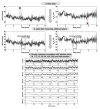Cerebral Hemodynamics in Asphyxiated Newborns Undergoing Hypothermia Therapy: Pilot Findings Using a Multiple-Time-Scale Analysis
- PMID: 26858217
- PMCID: PMC4748172
- DOI: 10.1016/j.pediatrneurol.2015.11.010
Cerebral Hemodynamics in Asphyxiated Newborns Undergoing Hypothermia Therapy: Pilot Findings Using a Multiple-Time-Scale Analysis
Abstract
Background: Improved quantitative assessment of cerebral hemodynamics in newborns might enable us to optimize cerebral perfusion. Our objective was to develop an approach to assess cerebral hemodynamics across multiple time scales during the first 72 hours of life in newborns during hypothermia therapy.
Methods: Spontaneous oscillations in mean arterial pressure and regional cerebral tissue oxygen saturation were analyzed using a moving window correlation method with time scales ranging from 0.15 to 8 hours in this pilot methodology study. Abnormal neurodevelopmental outcome was defined by Bayley III scores and/or cerebral palsy by age 24 months using receiver operating curve.
Results: Multiple-time-scale correlations between the mean arterial pressure and regional cerebral tissue oxygen saturation oscillations were tested in 10 asphyxiated newborns undergoing hypothermia therapy. Large noninduced fluctuations in the blood pressure were observed during cooling in all five infants with abnormal outcomes. Notably, these infants had two distinct patterns of correlation: a positive in-phase correlation at the short time scales (15 minutes) and/or a negative antiphase correlations observed at long time scales (4 hours.). Both the in-phase (area under the curve 0.6, [95% confidence interval 0.2-0.95]) and antiphase correlations (area under the curve 0.75, [95% confidence interval 0.4-0.95]) appeared to be related to an abnormal outcome.
Conclusions: Our observations suggest that the time scale is an important factor that needs to be standardized in the assessment of neonatal cerebral hemodynamics.
Keywords: cerebral hemodynamics; hypothermia; hypoxic-ischemic encephalopathy (HIE); near infrared spectroscopy (NIRS); neonate.
Copyright © 2016 Elsevier Inc. All rights reserved.
Conflict of interest statement
Figures



Similar articles
-
Near-infrared spectroscopy versus magnetic resonance imaging to study brain perfusion in newborns with hypoxic-ischemic encephalopathy treated with hypothermia.Neuroimage. 2014 Jan 15;85 Pt 1(0 1):287-93. doi: 10.1016/j.neuroimage.2013.04.072. Epub 2013 Apr 28. Neuroimage. 2014. PMID: 23631990 Free PMC article.
-
A pilot cohort study of cerebral autoregulation and 2-year neurodevelopmental outcomes in neonates with hypoxic-ischemic encephalopathy who received therapeutic hypothermia.BMC Neurol. 2015 Oct 20;15:209. doi: 10.1186/s12883-015-0464-4. BMC Neurol. 2015. PMID: 26486728 Free PMC article.
-
Early predictors of short term neurodevelopmental outcome in asphyxiated cooled infants. A combined brain amplitude integrated electroencephalography and near infrared spectroscopy study.Brain Dev. 2013 Jan;35(1):26-31. doi: 10.1016/j.braindev.2011.09.008. Epub 2011 Nov 13. Brain Dev. 2013. PMID: 22082686
-
Hypothermia therapy for newborns with hypoxic ischemic encephalopathy.J Pediatr (Rio J). 2015 Nov-Dec;91(6 Suppl 1):S78-83. doi: 10.1016/j.jped.2015.07.004. Epub 2015 Sep 4. J Pediatr (Rio J). 2015. PMID: 26354871 Review.
-
Novel interventions to reduce oxidative-stress related brain injury in neonatal asphyxia.Free Radic Biol Med. 2019 Oct;142:113-122. doi: 10.1016/j.freeradbiomed.2019.04.028. Epub 2019 Apr 27. Free Radic Biol Med. 2019. PMID: 31039399 Review.
Cited by
-
Cerebral Near Infrared Spectroscopy Monitoring in Term Infants With Hypoxic Ischemic Encephalopathy-A Systematic Review.Front Neurol. 2020 May 27;11:393. doi: 10.3389/fneur.2020.00393. eCollection 2020. Front Neurol. 2020. PMID: 32536901 Free PMC article.
-
Multimodal Measurements of Brain Tissue Metabolism and Perfusion in a Neonatal Model of Hypoxic-Ischaemic Injury.Adv Exp Med Biol. 2021;1269:203-208. doi: 10.1007/978-3-030-48238-1_32. Adv Exp Med Biol. 2021. PMID: 33966218
-
Role of Optical Neuromonitoring in Neonatal Encephalopathy-Current State and Recent Advances.Front Pediatr. 2021 Apr 9;9:653676. doi: 10.3389/fped.2021.653676. eCollection 2021. Front Pediatr. 2021. PMID: 33898363 Free PMC article. Review.
-
Relationships between cerebral autoregulation and markers of kidney and liver injury in neonatal encephalopathy and therapeutic hypothermia.J Perinatol. 2017 Aug;37(8):938-942. doi: 10.1038/jp.2017.64. Epub 2017 May 4. J Perinatol. 2017. PMID: 28471439 Free PMC article.
-
Three Physiological Components That Influence Regional Cerebral Tissue Oxygen Saturation.Front Pediatr. 2022 Jun 13;10:913223. doi: 10.3389/fped.2022.913223. eCollection 2022. Front Pediatr. 2022. PMID: 35769216 Free PMC article.
References
-
- Lassen NA. Cerebral blood flow and oxygen consumption in man. Physiological reviews. 1959 Apr;39(2):183–238. - PubMed
-
- Pryds O, Greisen G, Lou H, Friis-Hansen B. Vasoparalysis associated with brain damage in asphyxiated term infants. J Pediatr. 1990 Jul;117(1 Pt 1):119–125. - PubMed
-
- Laptook AR. Use of therapeutic hypothermia for term infants with hypoxic-ischemic encephalopathy. Pediatr Clin North Am. 2009 Jun;56(3):601–616. Table of Contents. - PubMed
-
- Laptook AR, Corbett RJ, Burns DK, Sterett R. A limited interval of delayed modest hypothermia for ischemic brain resuscitation is not beneficial in neonatal swine. Pediatr Res. 1999 Oct;46(4):383–389. - PubMed
-
- Laptook AR, Shalak L, Corbett RJ. Differences in brain temperature and cerebral blood flow during selective head versus whole-body cooling. Pediatrics. 2001 Nov;108(5):1103–1110. - PubMed
Publication types
MeSH terms
Grants and funding
LinkOut - more resources
Full Text Sources
Other Literature Sources

